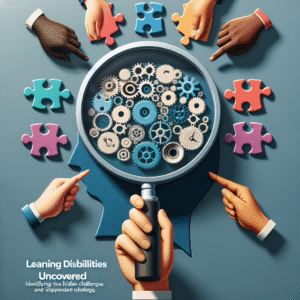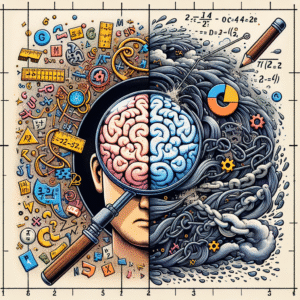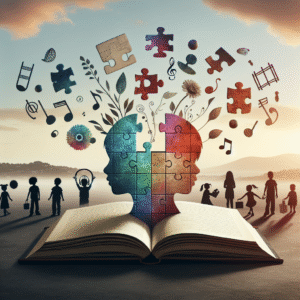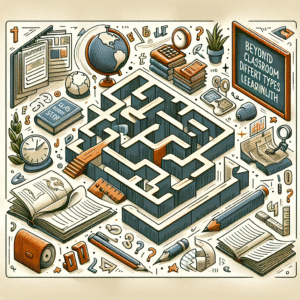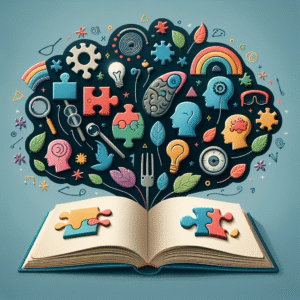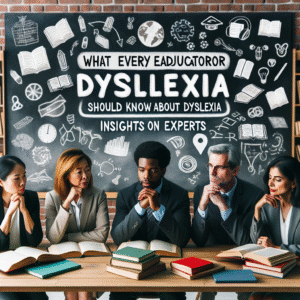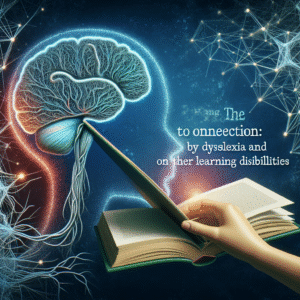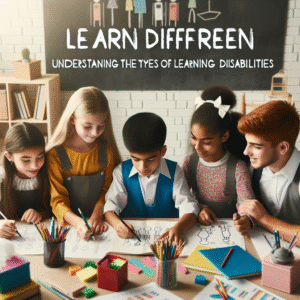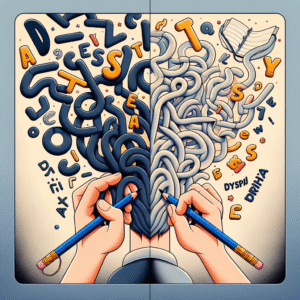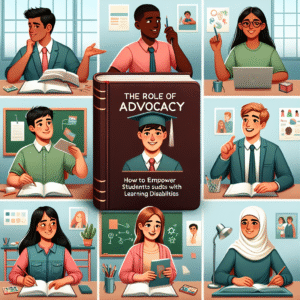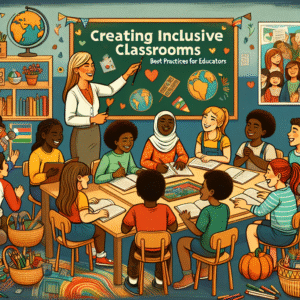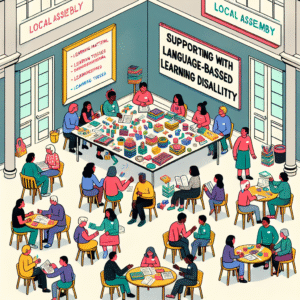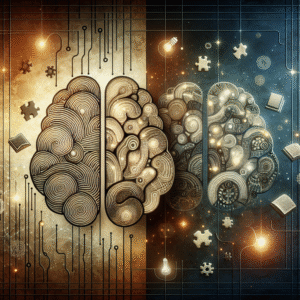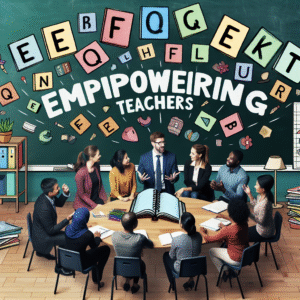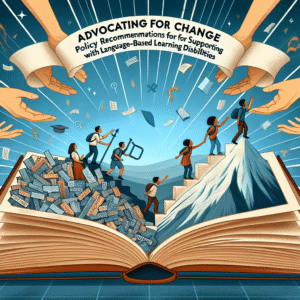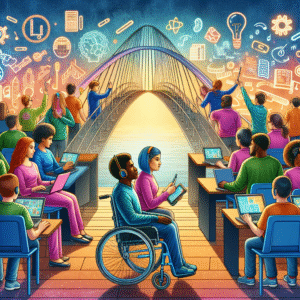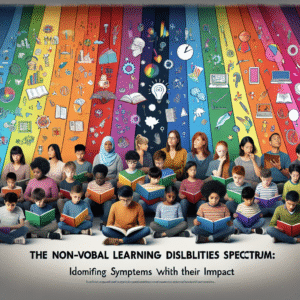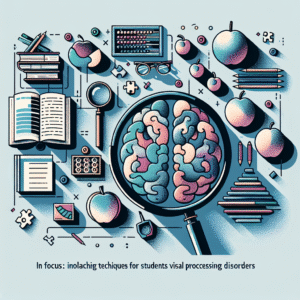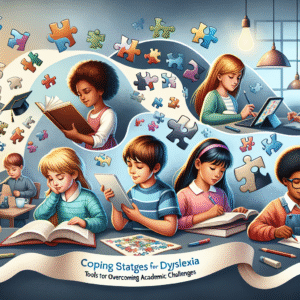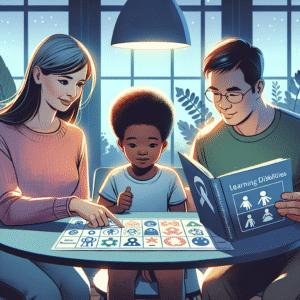Learning Disabilities Uncovered: Identifying the Hidden Challenges – The Ultimate Guide Introduction Imagine a child sitting in a classroom, surrounded by peers who seem to grasp complex concepts with ease. Yet, this child struggles, not due to a lack of intelligence but because of hidden challenges that often go unnoticed. Learning disabilities are frequently misunderstood, masked by societal misconceptions...
Non-verbal learning disabilities symptoms
From Confusion to Clarity: The Essential Process of Diagnosing Dyscalculia Introduction In a world driven by numbers—from managing personal finances to succeeding in academic environments—the struggle to comprehend quantities can feel bewildering. For many, including those with dyscalculia, this confusion can morph into heightened anxiety and frustration. Dyscalculia, often overshadowed by its more recognized counterparts like dyslexia, is a...
Breaking the Silence: Key Insights into Learning Disabilities Affecting Our Kids Introduction Imagine being a child in a classroom, surrounded by peers who seem to grasp concepts effortlessly while you struggle to keep up. This experience is a reality for many kids with learning disabilities, but the conversation around these challenges often remains hushed. In “Breaking the Silence: Key...
Beyond the Classroom: Exploring Different Types of Learning Disabilities Introduction Imagine a world where every child is equipped to learn in their own unique way, where the walls of the classroom aren’t the only bounds of education, and where understanding and compassion lead to a flourishing society. Learning disabilities affect millions of individuals, yet they often remain misunderstood. The...
Tools for Teachers: Effective Diagnosis of Dyscalculia in the Classroom Introduction Imagine walking into a classroom where every student’s unique needs are met, and no one is left behind. In a world striving for inclusivity and individualized learning, the challenge of dyscalculia—a learning difference affecting the ability to understand numbers and math concepts—can be daunting. Educators, however, possess a...
Navigating the Journey: Understanding Common Learning Disabilities in Children Introduction In a world where every child’s journey through education is uniquely intricate, the challenges posed by learning disabilities can often feel overwhelming—both for the children experiencing these difficulties and for their families. By understanding these common learning disabilities, we pave the way to navigate this journey more effectively. As...
Understanding Learning Disabilities: An Essential Comprehensive Guide Introduction Imagine a world where every child has the opportunity to learn without barriers. However, for millions of children and adults, learning disabilities create significant challenges that prevent them from unlocking their full potential. Understanding Learning Disabilities: A Comprehensive Guide is not just about identifying the obstacles but also about embracing the...
The Hidden Struggle: Recognizing Dyscalculia in Students – An Essential Guide Introduction Imagine a classroom where numbers dance before a child’s eyes, swirling like unwritten poetry, yet remaining perpetually out of reach. For many students, math is not just a subject; it’s an uphill battle. This article dives into The Hidden Struggle: Recognizing Dyscalculia in Students, a learning disability...
Lessons Learned: How Dyslexia Shaped the Lives of Famous Innovators Introduction Dyslexia has often been misunderstood as merely a learning difficulty, but many who traverse this frequently stigmatized path become some of society’s most notable innovators. The narrative surrounding dyslexia is filled with stories of resilience, creativity, and unique perspectives. It becomes evident that, rather than being...
Beyond Basic Math: Understanding and Diagnosing Dyscalculia Introduction Mathematics is often seen as a universal language, a foundational skill necessary for personal and academic success. However, for some individuals, navigating the world of numbers can feel like an insurmountable challenge. Enter dyscalculia—a specific learning disability that affects an individual’s ability to understand, learn, and perform math-related tasks. In this...
The Emotional Toll: Understanding Anxiety and Self-Esteem in Dyslexic Students Introduction Dyslexia is often misunderstood. Beyond its core characteristics—difficulty with reading, writing, and spelling—lies a profound emotional landscape that can severely impact self-esteem and lead to anxiety. The emotional toll that these struggles take on dyslexic students is significant and warrants a closer examination. Understanding this emotional toll is...
Diagnosing Dyscalculia: The Ultimate Roadmap for Parents and Educators Introduction Imagine sitting in a classroom, surrounded by peers who effortlessly navigate numbers and equations while you struggle to comprehend the simplest of calculations. For many, this scenario is more than just a moment of frustration; it’s a daily reality shaped by dyscalculia. This specific learning disability can leave students...
What Every Educator Should Know About Dyslexia: Insights from Experts Introduction In today’s diverse classrooms, one of the most pressing challenges educators face is understanding and supporting students with dyslexia. As awareness of learning disabilities grows, educators must become equipped with the knowledge and tools necessary to help these learners thrive. Dyslexia is not merely a reading difficulty but...
Counting the Signs: How to Recognize and Diagnose Dyscalculia – The Essential Guide Introduction Imagine stepping into a classroom filled with laughter and the scribble of crayons on paper. The teacher’s enthusiastic voice fills the air, explaining an exciting new math concept. But in the corner, a child frowns, furrowing their brow in confusion. For them, numbers might as...
Redefining Success: Celebrating Achievements in the Face of Learning Challenges Introduction In a world that often equates success with traditional metrics—grades, promotions, or accolades—it’s crucial to explore a new narrative. Redefining success: celebrating achievements in the face of learning challenges invites us to broaden our understanding of what it means to succeed. This perspective emphasizes the journey, the struggles...
Ultimate Guide: Feel Free to Adjust or Combine Any of These Ideas to Better Suit Your Specific Article! Introduction Have you ever stared at a blank page, your mind a whirlwind of ideas, but nothing seemed to click? In today’s fast-paced world, content creation demands not only creativity but also adaptability. That’s where the idea of being flexible—feeling free...
Unraveling the Numbers: The Ultimate Guide to Diagnosing Dyscalculia Introduction In a world increasingly dominated by numbers, the ability to understand and manipulate them is crucial. Yet, for some individuals, this task can feel insurmountable. Enter dyscalculia, a learning disability that affects approximately 5% of the population, challenging their ability to grasp numbers and mathematical concepts. Unraveling the Numbers:...
Exploring the Connection: Dyslexia and Other Learning Disabilities—An Essential Guide Introduction Imagine navigating a world that appears to have its own set of rules, but you can’t read the instructions. For those with dyslexia and other learning disabilities, this is a daily reality that can foster unique challenges, yet also tremendous resilience. In this article, we will take a...
Learn Different, Succeed Together: Understanding the Types of Learning Disabilities for a Brighter Future Introduction In a world that values innovation and creativity, the term "learning disabilities" may seem like a barrier to some, but it’s essential to understand that these challenges can be pathways to unique strengths. Each child has a distinctive way of absorbing information, and recognizing...
The Ultimate Guide for Dyscalculia: Understanding, Coping, and Thriving Introduction Imagine struggling with numbers in a world that runs on math. For many, everyday tasks become overwhelming when battling a condition known as dyscalculia. It’s more than just a learning disability; it affects how individuals perceive and interact with numerical concepts, leading to frustration and anxiety. This comprehensive guide...
Learning Disabilities Unveiled: The Proven Contrast Between Dyslexia and Dysgraphia Introduction In a world that increasingly values literacy and communication, the significance of understanding learning disabilities cannot be overstated. Among the plethora of challenges children and adults face, dyslexia and dysgraphia stand out as two prevalent yet often misunderstood learning disabilities. Learning Disabilities Unveiled: The Contrast Between Dyslexia and...
The Role of Advocacy: How to Empower Students with Learning Disabilities for Lasting Success Introduction Imagine a classroom where every student flourishes, each one encouraged to harness their unique strengths, including those with learning disabilities. The truth is, students with learning disabilities often face significant barriers in their educational journey. But hope isn’t lost—advocacy plays a pivotal role in...
Unlocking Potential: Essential Support and Strategies for Various Learning Disabilities Introduction In a world where education and innovation are more crucial than ever, understanding and addressing learning disabilities becomes a vital quest for both educators and families. Unlocking potential goes beyond mere acknowledgment of challenges; it involves a deep dive into actionable strategies that empower individuals with learning disabilities....
The Ultimate Journey to Diagnosis: Understanding Dyslexia in Children and Adults Introduction Imagine a world where letters dance on the page, where words refuse to cooperate, and reading feels more like a puzzle than a pleasure. For many individuals, dyslexia paints this vivid picture. Understanding dyslexia—its nuances and implications—is essential, not just for educators and parents, but for society...
From Letters to Lines: The Essential Differences Between Dyslexia and Dysgraphia Explored Introduction Imagine sitting in a classroom, your peers darting pencils across clean sheets of paper while your own words feel jumbled and distant. For many students and even adults, this experience is a daily struggle—a struggle often rooted in distinct yet commonly confused learning differences: dyslexia and...
Creating Inclusive Classrooms: Essential Best Practices for Educators Introduction Imagine a classroom where every student feels valued, understood, and equipped to thrive. Creating inclusive classrooms is not just a trend; it’s a necessity in today’s diverse educational landscape. This foundational approach ensures that all students—regardless of their backgrounds or abilities—can shine. In a world where differences enrich our experiences,...
The Essential Importance of Awareness: Recognizing Different Types of Learning Disabilities Introduction It’s a sobering reality: Learning disabilities affect millions of children and adults across the globe, yet many people remain unaware of their existence and impact. Imagine walking into a classroom or an office where individuals face daily challenges, not due to a lack of intelligence or desire...
Breaking Down Dyslexia: Diagnosing the Learning Disability with Confidence Introduction Dyslexia isn’t just a buzzword; it’s a pervasive learning disability that affects millions around the world. Imagine facing the daunting task of reading a simple text while your peers breeze through it effortlessly. This condition often leads to feelings of frustration, low self-esteem, and confusion. However, diagnosing dyslexia shouldn’t...
Engaging the Community: How Local Programs Can Support Students with Language-Based Learning Disabilities Introduction Imagine walking into a classroom buzzing with energy, where each student is not only learning but thriving. For many children, however, this vision is clouded by the challenges posed by language-based learning disabilities (LBLD). The truth is, these disabilities, which affect aspects such as reading,...
Learning Through a Different Lens: The Impact of Visual Processing Disorders on Academic Performance 

Learning Through a Different Lens: The Impact of Visual Processing Disorders on Academic Performance
Learning Through a Different Lens: The Profound Impact of Visual Processing Disorders on Academic Performance Introduction Imagine sitting in a classroom filled with eager students, each one ready to absorb knowledge. But for some, the experience is drastically different—not due to a lack of intelligence or desire but because of undiagnosed visual processing disorders (VPDs) that affect how they...
Comparing Dyslexia and Dysgraphia: What Sets Them Apart? The Ultimate Guide Introduction When it comes to learning difficulties, dyslexia and dysgraphia are two terms that often arise. Understanding the nuances between them is more than just academic; it has crucial implications for education, parenting, and personal growth. Dyslexia, typically characterized by difficulties in reading, and dysgraphia, a struggle with...
Learning Disabilities Beyond Dyslexia: Understanding ADHD, Dysgraphia, and More Introduction In a world where academic success often dictates future opportunities, understanding the complexities of learning disabilities is paramount. While dyslexia has garnered the lion’s share of attention, other conditions like ADHD (Attention-Deficit/Hyperactivity Disorder) and dysgraphia deserve equal focus. This article—Learning Disabilities Beyond Dyslexia: Understanding ADHD, Dysgraphia, and More—aims to...
Shedding Light on Learning Disabilities: Types, Diagnosis, and Treatment Options Introduction Imagine a classroom filled with students, some eagerly raising their hands, while others struggle silently, grappling with challenges invisible to their peers and teachers. Learning disabilities affect millions of students worldwide, hindering their ability to grasp essential concepts despite normal intelligence. Shedding light on learning disabilities: types, diagnosis,...
Diagnosis Matters: The Essential Role of Early Intervention in Dyslexia Introduction Imagine a child sitting at a desk, struggling with words that seem to dance on the page. Despite their intelligence and potential, they may face an uphill battle if dyslexia goes undiagnosed. The adage “Diagnosis Matters” rings especially true in this context—highlighting how critical early detection and intervention...
The Ultimate Guide to Language-Based Learning Disabilities and Mental Health: Understanding the Connection Introduction When we think about learning disabilities, we often picture challenges in reading, writing, and speaking. Yet, the hidden complexities of Language-Based Learning Disabilities (LBLDs) extend far beyond the classroom. They weave an intricate connection with mental health that deserves our attention. But why should we...
Visual Processing Disorders: An Essential Guide for Parents and Educators Introduction Imagine watching your child struggle in school despite their intelligence and effort. Their grades don’t reflect their understanding, and simple tasks like reading or writing seem insurmountable at times. This can be a common scenario for children dealing with Visual Processing Disorders (VPD). As a parent or educator,...
Decoding Learning Differences: The Distinctive Nature of Dyslexia and Dysgraphia – The Essential Guide to Understanding and Supporting Unique Learners Introduction: The Urgency of Understanding Learning Differences In today’s educational landscape, the terms "dyslexia" and "dysgraphia" may often surface in discussions about learning differences, yet they are frequently misunderstood and underappreciated. With approximately 15% of the population grappling with...
Empowering Teachers: Essential Professional Development for Effective Dyslexia Support Introduction Dyslexia is one of the most prevalent learning disabilities affecting millions of children worldwide. Despite its impact, many educators feel ill-equipped to support students with dyslexia adequately. Unfortunately, a lack of understanding can lead to missed opportunities for enhancing these students’ learning experiences. This situation underscores the compelling need...
Understanding Learning Disabilities: How They Affect Learning and Development Introduction In an age where educational success is often equated with intelligence, it’s crucial to understand that not every child learns in the same way. This exploration of "Types of Learning Disabilities: How They Affect Learning and Development" reveals not just the challenges faced by individuals with learning disabilities but...
Navigating Dyslexia: Essential Tools for Accurate Diagnosis Introduction Dyslexia, a common learning difficulty, affects millions of individuals worldwide, yet it remains misunderstood and frequently misdiagnosed. Navigating the complexities of dyslexia can feel like traversing a labyrinth without a map. Each twist and turn holds the potential for insight or confusion. With the right tools and understanding, however, accurate diagnosis...
The Ultimate Guide to Crafting Engaging Content: Feel Free to Modify These to Better Suit Your Target Audience! Introduction In the ever-evolving landscape of digital communication, one truth remains constant: content is king. Whether you’re a seasoned marketer, a budding entrepreneur, or an educator, understanding how to engage your audience is essential. This article delves into the nuances of...
Advocating for Change: Essential Policy Recommendations for Supporting Students with Language-Based Learning Disabilities Introduction In a world where education is often touted as the great equalizer, an alarming number of students are left behind due to language-based learning disabilities (LBLD). The challenge is not the intelligence of these students, but rather the systems in place that sometimes fail to...
Beyond Eye Exams: A Comprehensive Look at Visual Processing Disorders in Children Introduction Imagine a world where your child struggles to read not because they can’t see the words, but because their brain processes visual information differently. Visual processing disorders (VPDs) are often overlooked, even though they can profoundly impact a child’s learning and daily life. Beyond Eye Exams:...
The Ultimate Guide to Dyslexia and Dysgraphia: Symptoms, Diagnosis, and Key Differences Introduction Navigating the complexities of learning disabilities can feel overwhelming for families, educators, and individuals alike. Dyslexia and dysgraphia are two of the most common learning disorders that affect reading and writing skills, respectively. But understanding the nuances between the two—particularly their symptoms, diagnosis, and key differences—can...
Bridging the Gap: How Technology is Transforming Learning for Students with Disabilities Introduction In an era where technology permeates every aspect of our lives, it stands as a beacon of hope for countless students facing disabilities. Education is not just about books and classrooms; it’s about unlocking the potential that every individual holds within. Bridging the Gap: How Technology...
The Ultimate Guide to Tailoring Content: Feel Free to Modify These Suggestions to Better Fit Your Target Audience or Specific Focus! Introduction In today’s hyper-customized digital landscape, the mantra “Feel free to modify these suggestions to better fit your target audience or specific focus!” has never been more relevant. Whether you’re a seasoned marketer, a budding entrepreneur, or a...
Unlocking Communication: Essential Tools and Techniques for Managing Auditory Processing Disorder Introduction Auditory Processing Disorder (APD) can be a silent disruptor in a person’s life, affecting communication and social interactions in profound ways. Combatting APD isn’t simply a matter of adjusting how one listens; it requires a multifaceted approach that empowers individuals to unlock their full communicative potential. In...
The Ultimate Guide to The Non-Verbal Learning Disabilities Spectrum: Identifying Symptoms and Their Impact Introduction: Understanding a Hidden Challenge Imagine a child who excels in academics yet struggles profoundly with social interactions. This incongruity might lead you to the realm of Non-Verbal Learning Disabilities (NVLD), a spectrum of challenges that affect how individuals perceive and interact with the world....
The Intersection of Language, Culture, and Learning Disabilities: A Closer Look at Essential Insights Introduction In today’s increasingly interconnected world, understanding the nuanced relationship between language, culture, and learning disabilities is not just an academic pursuit—it’s vital for educators, parents, and policymakers alike. As we delve into The Intersection of Language, Culture, and Learning Disabilities: A Closer Look, we...
In Focus: Innovative Teaching Techniques for Students with Visual Processing Disorders Introduction Imagine walking into a classroom buzzing with energy, where every student engages seamlessly with the lessons taught. Now, visualize a student struggling, overwhelmed by visual information that others seem to grasp easily. For many students with Visual Processing Disorders (VPD), this is a daily reality. In Focus:...
The Overlap and Divergence: How Dyslexia and Dysgraphia Impact Learning – The Essential Guide Introduction In an increasingly complex educational landscape, understanding the unique challenges faced by students with learning disabilities is paramount. Among these challenges, dyslexia and dysgraphia stand out, often creating overlapping symptoms and divergent paths in students’ learning journeys. The intersection of these two conditions can...
Essential Coping Strategies for Dyslexia: Tools for Overcoming Academic Challenges Introduction Dyslexia affects around 10% of the population, yet its impact on academic performance can be profound. For many individuals with dyslexia, navigating the traditional educational system can feel like climbing a steep mountain—challenging, but not insurmountable. The key lies in implementing effective coping strategies for dyslexia. These tools...
A Parent’s Guide to Learning Disabilities: Recognizing Types and Seeking Help for Your Child’s Success Introduction Navigating the world of education can feel overwhelming, especially when your child is facing challenges that others might not understand. From difficulties in reading to struggles with math, learning disabilities can manifest in various ways, affecting your child’s confidence and academic performance. However,...
The Essential Role of School Assessments in Diagnosing Dyslexia: What You Need to Know Introduction Imagine a bright child who loves stories but struggles to read the words on the page. This dichotomy often raises concerns about potential learning disabilities, particularly dyslexia—a condition affecting millions of children worldwide. The importance of early diagnosis cannot be overstated; it lays the...
Math Doesn’t Have to Be Hard: Understanding Dyscalculia Symptoms in Students Introduction Mathematics often evokes a sense of dread for many students, and for those with dyscalculia, a specific learning difficulty, this fear can be even more pronounced. However, it’s essential to understand that math doesn’t have to be hard, even for students struggling with dyscalculia. By identifying symptoms...
Voices Unheard: Raising Awareness About Auditory Processing Disorder in Kids Introduction: The Silent Struggle Every child deserves to have their voice heard, yet many remain unheard due to complexities that are not easily identifiable. Auditory Processing Disorder (APD) is one such issue that affects children’s ability to interpret sounds in their environment correctly. It isn’t merely a hearing issue;...
Breaking Down NVLD: What to Look For and How to Help – The Ultimate Guide Introduction In a world that values adaptability and quick thinking, many individuals struggle to navigate social cues and pragmatic problem-solving. Non-Verbal Learning Disorder (NVLD) is one such condition that often escapes attention, leaving those affected at a disadvantage. Understanding NVLD is essential—not just for...
Building a Supportive Environment: Essential Tips for Friends and Family of Children with Language-Based Learning Disabilities Introduction Imagine a world where every child feels understood and supported, especially when grappling with challenges that alter the way they communicate and learn. Language-based learning disabilities (LBLD) can profoundly impact a child’s ability to express themselves, grasp concepts, and engage in social...
The Hidden Hurdle: Identifying Visual Processing Disorders in Academic Settings Introduction In the bustling world of education, where every child is expected to thrive, there’s an invisible barrier that often goes unnoticed—the challenge of visual processing disorders. This "hidden hurdle" can significantly impact a child’s learning experience but frequently remains undiagnosed in academic environments. Imagine a bright student who...
Early Identification: How Recognizing Language-Based Learning Disabilities Early Can Change Lives Introduction Imagine a world where every child, regardless of their learning challenges, has the opportunity to thrive academically and socially. Early identification: how recognizing language-based learning disabilities early can change lives. This powerful statement underscores the importance of recognizing these learning challenges as early as possible. In today’s...
